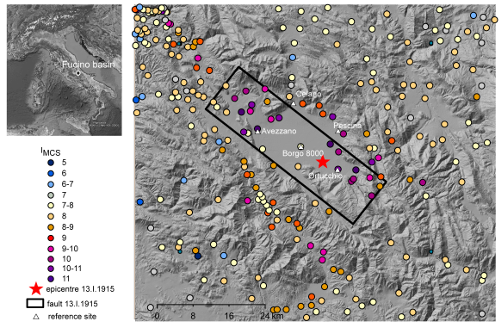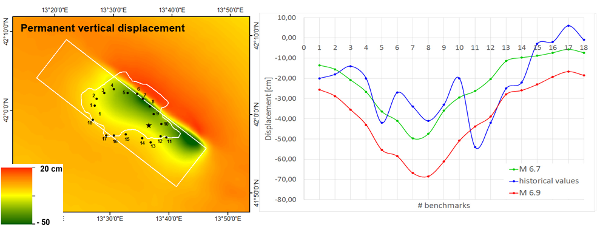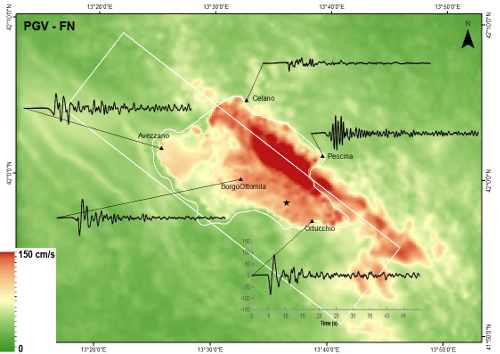Paolucci R., Evangelista L., Mazzieri I., Schiappapietra E., The 3D Numerical Simulation of Near-Source Ground Motion during the Marsica Earthquake, Central Italy, 100 years later, in Proceedings of 6ICEGE-6th International Conference on Earthquake Geotechnical Engineering, 1-4 November 2015, Christchurch, New Zealand.
Introduction
On January 13, 1915, at 6:52 local time, a catastrophic earthquake devastated Marsica, Southern Abruzzi, Central Italy, causing around 33,000 fatalities. Among the most important municipalities hit by the earthquake, the ruin of Avezzano was completed, with 10,700 fatalities, 95% of the total population (CFTI, 2015). A single reinforced concrete building in Avezzano, one of the very first ones at those times, withstood the earthquake and was later declared national monument.
The earthquake was originated by the Fucino fault system (Galadini and Galli, 1999), consisting of an array of NW-SE striking normal faults, dipping mainly SW, which is also attributed to have generated the earthquake which severely affected Rome in 508 AD (Galli et al., 2012).

(a) 3D computational mesh adopted for the numerical model along with the projection of the seismic fault responsible of the January 13 1915 earthquake and buried topography, corresponding to Quaternary sediments. (b) Assumed slip distribution to model the earthquake fault rupture. (c) Mechanical properties for the stratified bedrock (left) and the Fucino basin (right).
Numerical Model
The distinctive features of the numerical model are
- a kinematic representation for the seismic fault rupture of the 13 January 1915 earthquake
- inclusion of a 3D velocity model of the Fucino valley, taking into account the spatial variation of the most relevant geologic discontinuities beneath the surface sediments, which have significant effects on the seismic wave propagation
Numerical Results
Comparison with post-earthquake geodetic measurements
We have first verified the adequacy of the fault slip distribution model by comparing the simulated vertical displacements with the post-earthquake geodetic measurements (values taken from Berardi et al., 1995). The comparison is shown for two values of Mw, obtained by changing the amplitude of slip distribution. The best agreement was found for Mw 6.7, compatible with the best solution of Amoruso et al. (1998) who found the minimum misfit with Mw 6.6±0.1.
Peak Ground Velocity Map
We report a peak ground velocity (PGV) map of the Fault Normal (FN) component, together with the corresponding velocity records. Here, the observed variability of ground motion is striking, with the different features of ground motion observed on the footwall (Pescina and Celano) and on the hanging wall of the fault (Ortucchio, Borgo8000, Avezzano) are probably related to the coupling of different soil conditions and different location with respect to the fault plane. It is also worth to remark that the largest PGV values occur close to the edge of the surface projection of the fault plane.
References
Amoruso A, Crescentini L, Scarpa R. Inversion of source parameters from near and far-field observations: an application to the 1915 Fucino earthquake, Central Apennines, Italy. Journal of Geophysical Research 1998; 103(B12): 29,989-29,999.
Berardi R, Mendez A, Mucciarelli M, Pacor F, Longhi G, Petrungaro C. On the modelling of strong motion parameters an correlation with historical macroseismic data: an application to the 1915 Avezzano earthquake. Annali di Geofisica 1995; 38: 851-866.
Cara F, Di Giulio G, Cavinato GP, Famiani, Milana G. Seismic characterization and monitoring of Fucino Basin (Central Italy). Bull. Earthquake Eng 2011; 9:1961-1985.
Cavinato GP, Carusi C, Dall’Asta M, Miccadei E, Piacentini T. Sedimentary and tectonic evolution of Plio-Pleistocene alluvial and lacustrine deposits of Fucino basin (Central Italy). Sedimentary Geology 2002; 148: 29-59.
Galli P, Messina P, Giaccio B, Peronace E, Quadrio B. Early Pleistocene to late Holocene activity of the Magnola fault (Fucino fault system, central Italy). Bollettino di Geofisica Teorica ed Applicata 2012; 53: 435-458.
Galadini F and Galli P. The Holocene paleoearthquakes on the 1915 Avezzano earthquake faults (central Italy): Implications for active tectonics in Central Apennines. Tectonophys 1999; 308: 143-170.



